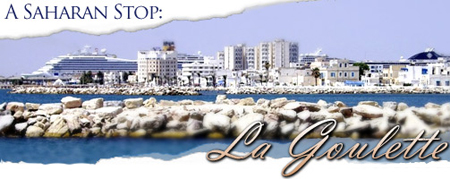|

La
Goulette, Tunisia: A Holland America Port
The
small, coastal country of Tunisia provides
travelers with an unique opportunity to
visit the Mediterranean coast of Northern
Africa - a scenic place were low hills
and countryside meet the Atlas Mountains.
The port city gives visitors a peak into
the Saharan community, its culture, architecture
and popular shopping stops.
What
to See
Medina, the Tunisian UNESCO World Heritage
Site, is filled with spectacular monuments
that can go easily unseen if you aren't
aware of what to look for. Research the
rich area before stopping at the port,
so you are able to enjoy its views and
architectural sites. The city's atmosphere
is wonderful for walking, and even though
you may become temporarily lost in its
maze of streets, there's no greater place
to stroll and soak up the atmosphere.
The city's central street is lined with
souvenir vendors. However, duck into some
of the area's side streets to experience
the authentic Tunis. Traditional tea shops
seem to be everywhere, but each location
provides a service that brings it faithful
customers who congregate on a regular
basis to share tea and friendly conversation.
Only Muslims are permitted to enter the
central 18th-Century Great Mosque Ez-Zitouna
(Mosque of the Olive Tree), since it is
the nation's most revered shrine. Some
observers claim the mosque was built in
the 17th Century, when Islam arrived from
Egypt. Despite its conflicted history,
the Great Mosque Ez-Zitouna remains a
respected site. Only highly-respected
tradesmen are allowed to set up shop in
its vicinity, making the area surrounding
the temple the core of Medina. History
stands near the building, as the columns
surrounding its enclosed yard were salvaged
from Carthage years ago.
Souk al Attarine (Perfume Souk) is popular
near the mosque. According to Tunisian
custom, these perfumed scents signifies
particular cultural ceremonies and events.
Fragrant oils are inexpensive, so while
you are there you can mix purchased oils
to create your own signature blend. The
Prime Minister's official office, Dar
el Bey, sits opposite the souk, where
it was originally built in 1795.
When traveling, remember to keep your
camera under wraps. Although Tunis is
a very cosmopolitan area, it's also best
to cover any bare skin. It's consider
taboo to wear shorts or sleeveless tops
as well. Following these cultural rules
will keep you from being easily identified
as a tourist.
Another incredible site to visit is the
Dar Ben Abdallah Palace, which was built
at the end of the 18th Century. Umayyad
rulers began work on the detailed façade
in 732 A. D., though the Aghlabites finished
the work in 864 A.D. Preserved as a remarkable
museum, the palace's displays reveal something
of 19th-Century Tunisian life. Included
in the displays are a series of traditional
costumes, implements and everyday accessories.
The Bardo Museum, another favorite visit,
is unchallenged as Tunisia's finest collection
of art. Just west of Medina, the museum
is set inside an antique palace surrounded
by pretty gardens. The art holdings are
organized according to the history of
regional rule, and they offer visitors
insight into the influences that shaped
modern Tunisia. The Roman mosaic collection
is magnificent, featuring tiled objects
that were brought from nearby Thuburbo
Majus - a Punic city favored among Russians.
History
In early Tunisian history, the expanding
Sahara separated Berber tribes from ancestral
Egyptians by 3,000 B.C., and strong cultural
distinctions were formed. While permanent
Egyptian communities rose from the fertile
and water-rich Nile Valley, Berbers were
forced to live mostly nomadic lives, following
scarce and shifting water and food supplies.
The powerful Egyptian Pharaohs could have
led incursions along the coast, but their
interest always remained focused on the
fertile upper Nile Valley. Hence, they
never attempted to extend their influence
east or west. In turn, the remainder of
the North African coast developed its
own civilizations as Phoenician and Greek
settlers began setting up trading colonies.
During this same time, the Punic Empire
grew powerful, dominating the region for
a period of time. However, after the Carthaginian
commander Hannibal was expelled, the Punic
Empire began to decline and Roman soldiers
destroyed Carthage in 146 B.C. The Roman
rule was eventually undermined when the
emperors tried to suppress Christianity.
In spite of their best efforts, the new
faith spread across the land. In North
Africa, however, Christians were supplanted
by armies of Arabs who streamed out of
the Middle East in the 7th Century with
Mohammed's messages of Islam.
Read
more on the Holland
America10-Day Mediterranean Cruise.
|